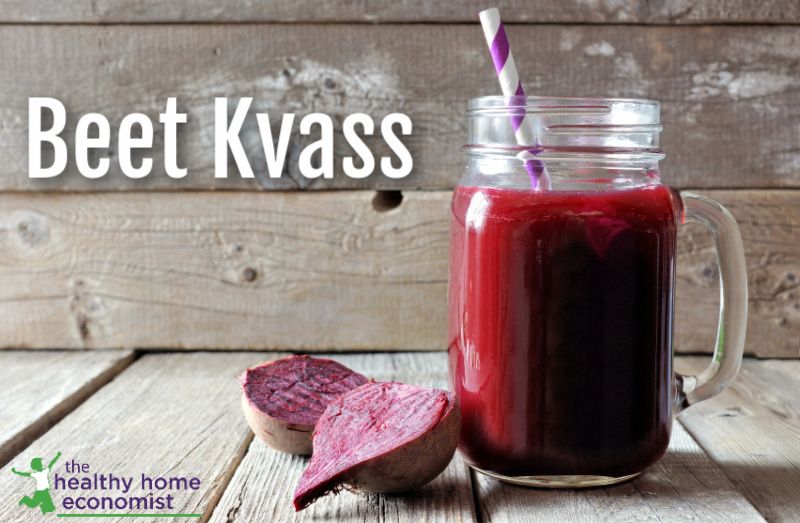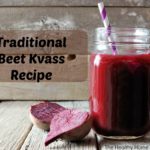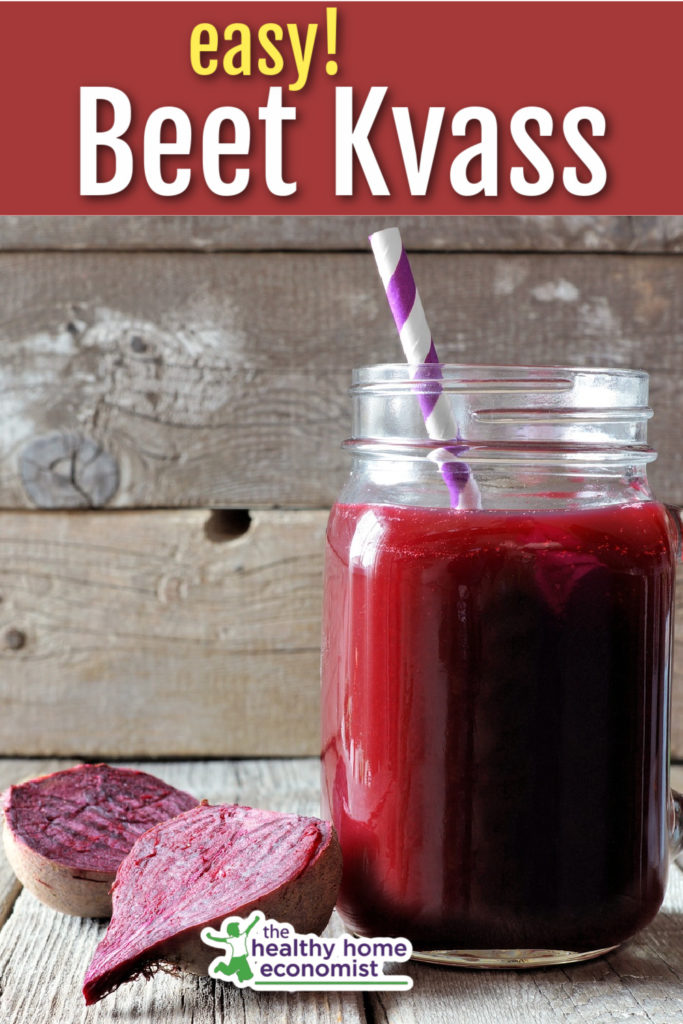Table of Contents[Hide][Show]
Beet kvass is potent, nutrient-rich tonic made by fermenting beets. It is essentially a DIY liquid multivitamin and more effective than taking brands from the store that contain synthetics!

One of the most nutritious and health-boosting fermented beverages you can make in your home is beet kvass. Beets are chock full of vitamins and minerals. Fermenting them supercharges nutrient levels even further and enhances absorption potential.
This ancestral tonic is extremely beneficial to those with any sort of digestive complaints.
In addition, beets are highly cleansing, so those with liver issues benefit from consuming beet kvass on a regular basis.
There isn’t another fermented drink that can improve health as rapidly in my personal experience.
Beet Kvass: DIY Liquid Multivitamin!
As a tonic, beet kvass is recommended first thing in the morning and after your evening meal.
Just 4 ounces or so is all you need to sip.
This highly nutritious superfood is far better than taking a multivitamin loaded with synthetic vitamins like folic acid.
I’m sipping a morning glass of beet kvass as I type this! What a great way to start the day and rev up your digestion each morning!
The recipe below was adapted from Nourishing Traditions Cookbook.
Most people make kvass with red beets. For a slightly sweeter and less earthy flavor, try making golden beet kvass.
If you find the results a bit salty, reduce the sea salt in the recipe to your liking.

Beet Kvass Recipe
Traditional beet kvass recipe that is an unbeatable morning and evening tonic for rapidly boosting health.
Ingredients
- 1-2 beets (1 large or 2 medium) preferably organic, tops removed
- filtered water
- 2 Tbl liquid whey
- 1/2 Tbl sea salt
Instructions
-
Wash beets thoroughly and slice into chunks no smaller than about 1/2 inch across. Feel free to peel the beets if desired; doing so reduces chances for mold on the ferment.
-
Put beet chunks into a clean, one-quart mason jar. Add whey, sea salt, and enough filtered water to fill all but 1 inch from the top of the jar. Stir and mix well. Close the lid and leave on the kitchen counter for 1-2 days. Try to keep it away from the fruit bowl to discourage the growth of mold.
-
Drink as desired and refrigerate once the fermentation period is complete. A 4 ounce glass morning and evening is recommended.
-
When an inch or so of beet kvass liquid is left in the jar, refill with more filtered water, stir, and close the lid again and leave on the counter for 2 days more. Refrigerate fresh batch of beet kvass and drink as desired.
-
When all the liquid is used up from the second batch, discard or compost the beets and start the process again.
Recipe Video
Recipe Notes
If the beet kvass is too salty for you, feel free to reduce the salt to 1/4 tablespoon for your next batch.
White fuzzy bubbles forming on the top of the liquid is normal and fine as the fermentation progresses.

More Fermented Drink Recipes to Enjoy
How to Make Fermented Lemonade
Orangina Recipe (Fermented Orange Juice)
How to Make Kombucha








Someone above asked about the taste, but I didn’t see a reply…
Is this supposed to taste fermented? Mine has been out for about 36 hours now, but still just tastes like salty beet water…I was expecting it to be more kombucha like in flavor. Does it need to sit longer, or does it just taste like salty beet water when it’s done?
Would diluting this limit it’s effects? It’s REALLY salty to me and I LOVE salt, but if I could dilute it, I’d be much happier!
For the whey, I took organic yogurt and strained it…I used the whey left over, is that right? I was hoping I didn’t do something wrong and that’s why the flavor isn’t very strong. Thanks!
You did it right Janelle. Yes, it is quite salty. Feel free to dilute it if you like. It does get more bubbly over time in the refrigerator.
Hi Sarah, I’ve been making the NT Beet Kvass for about 8 months now. I hadn’t seen your video when I began and think I cut them way too small. I didn’t get much mold, but some batches poured literally like slime! Was that also from cutting them small, or fermenting too long in a warm kitchen? I hope to get an answer as I have been asked to demonstrate how to make this wonderful tonic for our local WAPF chapter in two weeks. I also use whey made from my homemade yogurt made with raw milk. Is this fine? I’m too lazy to make the one from just raw milk and because I make, then drain my own yogurt, like it this way. Thanks! Mikki
To help with the mold issue, do not cover the jar with a tight lid – just use a coffee filter or cheesecloth and secure with an elastic band. When I first tried to cover my kefir jar while fermenting, it developed mold (I usually don’t cover).
Hi Sarah,
My beets and kvass have lost ALL the red color after being refrigerated for a couple of months. Is this normal? It still smells o.k. and no mold has developed. Thanks for sharing your wisdom!
It’s fine! Drink up! 🙂
Sarah,
I am wondering how long the beet kvass lasts. I made a batch about 5 months ago and I haven’t drank much yet. Will it still be good? There is no mold and I keep it in the refrigerator. Also my daughter(10 yrs old) and I enjoy your videos very much and made our first batch of Hindu lemonade tonight. Thank you for a great healthy resource!
Hi Ann and Isabel, the beet kvass will probably be just fine. Fermentation plus refrigeration leads to quite a long shelf life in most cases. Glad you are enjoying the videos!! 🙂
Hi Joan, yogurt won't work here. You can double the salt and leave out the whey but the kjvass will be quite salty.
Sarah, I don't have any whey at this time, so can I use yogurt (made from raw milk) as a substitute, and if so, how much should I use? Thanks.
Joan
How critical are the measurements in the recipe? For the one quart version, you say to add 1/8 cup of the liquid whey, which would be 1 ounce. But in the video, you add a vessel containing what appears to be at least four times that amount (half a cup or more). Will I get the same results using an exact 1-ounce measurement of liquid whey and a half tablespoon of salt?
I noticed that also Ron. Did you ever get a reply, or did you experiment and figure it out?
Hi Sarah,
I'm glad I've found your blog. I'm originaly from Poland and beet kvass is quite popular over there ( it's a base for a traditional red borscht soup)- my family has been doing it for a long time. I usually add fresh garlic to mine ( it's a little spicy this way) and i know of people who add a piece of fresh horseradish root to it. My family drinks a glass every day – even my son likes it. I've never made it with whey before but will try it as soon as i get some raw milk -( found a supplier here in Chicago).
Madga, I’m from the Czech Rep. What do you make authentic Polish kvass with if not whey? I love love love borscht and make it often but use non fermented beets and water for it. Is that different from the way you make it in Poland?
Kamila
Question for
Dear Magda ,( refers to above question )
How does your recipe for the kvass differ from Sarah’s above video ? If you made her exact recipe in a quart jar, but used more salt instead of the whey, how much more salt would be needed? How big of a piece of horseradish for each quart as in Sarah’s recipe would you use? How many cloves of garlic per jar ? Thanks for this info about your recipe, as without the whey and with garlic and horseradish sounds delicious !! Then what do you add to the kavass to make the borscht soup ? Thanks again. Joella
Any beets are fine, Cathy.